2018/4/19 配置好了Mybatis的环境之后,接下来直接开始对增删改查进行测试.
1.建立一个数据库
CREATE TABLE category_ (
`id` int NOT NULL AUTO_INCREMENT ,
`name` varchar(255) NULL ,
PRIMARY KEY (`id`)
); insert into category_ (name) values('萧敬腾');
insert into category_ (name) values('德玛');
insert into category_ (name) values('kh');
insert into category_ (name) values('tom');
insert into category_ (name) values('jack');2.查询操作
在com..kh.mybatis;新建一个TestSelect.java
根据mybatis的结构图来创建所需的sqlSession会话;
通过sqlSession来操作JDBC事务来操作数据库;
通过session.selectOne获取id=1的记录
package com.kh.mybatis;
import java.io.IOException;
import java.io.InputStream;
import org.apache.ibatis.io.Resources;
import org.apache.ibatis.session.SqlSession;
import org.apache.ibatis.session.SqlSessionFactory;
import org.apache.ibatis.session.SqlSessionFactoryBuilder;
import com.kh.pojo.Category;
public class TestSelect {
//根据id查询用户信息,得到一条记录结果
public static void main(String[] args) throws IOException {
//获得mybatis的环境配置文件
String resource="mybatis-config.xml";
//以流的方式获取recource(mybatis的环境配置文件)
InputStream inputStream=Resources.getResourceAsStream(resource);
//创建会话工厂
SqlSessionFactory sqlSessionFactory=new SqlSessionFactoryBuilder().build(inputStream);
//通过工厂得到SqlSession
SqlSession sqlSession= sqlSessionFactory.openSession();
//通过SqlSession操作数据库
//selectOne 根据英语单词字面理解selectOne是只能查询出一条记录,也就是说返回结果为单条记录
Category cg=sqlSession.selection("FindById",1);//这里的FindById就是在Category.xml中配置的<select id="FindById">
System.out.println(cg); //Category.xml中的<select>标签的id名称不固定,顾名思义的起名字方便程序阅读
//释放资源
sqlSession.close();
}
}这里说一点:当查询结果为很多条的时候,我们使用:selectList(statement,pojo);来替代selectOne(statement,pojo);
在Category.xml文件中配置select的SQL语句,就可以映射到数据库中
在<mapper>标签中写SQL标签
<mapper namespace="com.kh.pojo">
<select id="FindById" parameterType="int" resultType="Category">
select * from category_ where id=#{id}
</select>
</mapper namespace="com.kh.pojo">这个SQL映射语句中:
namespace:一般设置为这个XML文件所在的package名字;
如:本项目的这个Category.xml 就在com.kh.pojo包下面.
在映射文件中配置很多SQL语句
id:标识映射文件中的SQL //和js里面通过标签的id操作标签属性一样
将SQL语句封装到mappedStatement对象中,所以将id称为statement的id.这句话对照mybatis学习笔记(一)
parameterType:制定输入参数的类型.本项目中Category.class 就是创建了一个新的JAVA数据类型,相当于C语言中 定义 结构体一样.在Java中叫做JavaBean
resultType:制定SQL输出结果所映射的JAVA对象类型,select制定resultType表示将单条记录影射成单条的Java对象, 学过JAVA泛型的人应该明白,在这里就不过多解释泛型了.
#{} 表示一个占位符号 '?' //就是 JDBC中的 select * from category_ where id=?;#{id}:其中id表示接受输入的参数,参数名称就是id
如果输入参数是简单类型#{}中的参数名可以任意,可以是value或其他名称#{中国}都行.
(这个简单类型我解释一下: 就是JAVA的八大基础数据类型:byte short int long float double char boolean.再加上一个String类型的)只要是括号里面的这些数据类型,#{}中可以随意填,你填啥填啥啦啦辣~
执行TestSelect后控制台输出:↓
Category cg=sqlSession.selectOne("FindById", 1);这句代码的意思就是:通过Category.xml中id="FindById"的这个标签(也就是<select>),执行它标签中的SQL语句,并把1赋给id.也就是说: 查找并输出id=1的那条记录.
---------------------------------------------------------------------------------------------------------------------------------
2.插入操作:
运行之后,如图所示可以看到 通过Mybatis插入的数据里有新增加的Category
通过session.insert调用InsertCategory对应的SQL语句
InsertCategory对应的插入sql语句,#{name}会自动获取c对象的name属性值
同样先在Category.xml的<mapper>标签中,配置<insert>标签
<mapper namespace="com.kh.pojo">
<select id="FindById" parameterType="int" resultType="Category">
select * from category_ where id=#{id}
</select>
<!-- 添加
paramType:制定输入参数的类型是pojo
-->
<insert id="InsertCategory" parameterType="Category">
insert into category_ (name) values(#{name})
</insert>
</mapper>执行语句
package com.kh.mybatis;
import java.io.IOException;
import java.io.InputStream;
import org.apache.ibatis.io.Resources;
import org.apache.ibatis.session.SqlSession;
import org.apache.ibatis.session.SqlSessionFactory;
import org.apache.ibatis.session.SqlSessionFactoryBuilder;
import com.kh.pojo.Category;
public class TestInsert {
//插入用户信息
public static void main(String[] args) throws IOException {
//mybatis配置文件
String resource="mybatis-config.xml";
InputStream inputStream=Resources.getResourceAsStream(resource);
//创建会话工厂
SqlSessionFactory sqlSessionFactory=new SqlSessionFactoryBuilder().build(inputStream);
//通过工厂得到SqlSessio
SqlSession sqlSession= sqlSessionFactory.openSession();
//插入用户
Category cg=newCategory();
cg.setName("rose");
sqlSession.insert("insertCategory",cg);
//提交事务
sqlSession.commit();
System.out.println("插入成功");
sqlSession.close();
}
}数据据结果为下:成功插入了"rose";
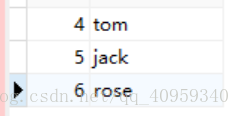
---------------------------------------------------------------------------------------------------------------------------------
3.修改信息
通过session.update进行修改
Category cg=new Category();
cg.setId(6);//设置修改X号 将id=6的 name改为"你好"
cg.setName("你好");//将X号的name改为=? 编写测试代码:
package com.kh.mybatis;
import java.io.IOException;
import java.io.InputStream;
import org.apache.ibatis.io.Resources;
import org.apache.ibatis.session.SqlSession;
import org.apache.ibatis.session.SqlSessionFactory;
import org.apache.ibatis.session.SqlSessionFactoryBuilder;
import com.kh.pojo.Category;
public class TestUpdate {
public static void main(String[] args) throws IOException {
//mybatis配置文件
String resource="mybatis-config.xml";
InputStream inputStream=Resources.getResourceAsStream(resource);
//创建会话工厂
SqlSessionFactory sqlSessionFactory=new SqlSessionFactoryBuilder().build(inputStream);
//通过工厂得到SqlSessio
SqlSession sqlSession= sqlSessionFactory.openSession();
//------------略略略----我是分割线--------------------------------------
Category cg=new Category();
cg.setId(6);//设置修改id=6的
cg.setName("你好");//将id=6的name改为"你好"
sqlSession.update("UpdateById",cg);
sqlSession.commit();
System.out.println("更新成功----");
sqlSession.close();
}
}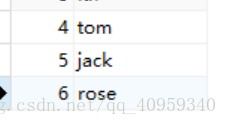 执行TestUpdate.class后
执行TestUpdate.class后 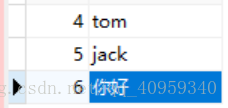
---------------------------------------------------------------------------------------------------------------------------------
4.删除操作:
DeteleById对应的sql语句:
<delete id="DeleteById" parameterType="Category" >
delete from category_ where id= #{id}
</delete>
package com.kh.mybatis;
import java.io.IOException;
import java.io.InputStream;
import org.apache.ibatis.io.Resources;
import org.apache.ibatis.session.SqlSession;
import org.apache.ibatis.session.SqlSessionFactory;
import org.apache.ibatis.session.SqlSessionFactoryBuilder;
import com.kh.pojo.Category;
public class TestDetele {
public static void main(String[] args) throws IOException {
//mybatis配置文件
String resource="mybatis-config.xml";
InputStream inputStream=Resources.getResourceAsStream(resource);
//创建会话工厂
SqlSessionFactory sqlSessionFactory=new SqlSessionFactoryBuilder().build(inputStream);
//通过工厂得到SqlSessio
SqlSession sqlSession= sqlSessionFactory.openSession();
//------------略略略----我是分割线--------------------------------------
sqlSession.detele("DeleteById",6);
//提交事务
sqlSession.commit();
System.out.println("删除成功");
sqlSession.close();
}
}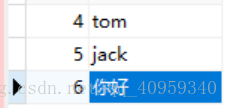 执行TestDelete.class后:
执行TestDelete.class后: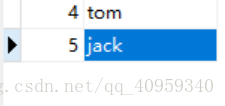
------------------------------------------------------------------------------------------------------------------------------
以上就是使用Mybatis实现一些基本的增删改查操作.欢迎留言讨论.























 被折叠的 条评论
为什么被折叠?
被折叠的 条评论
为什么被折叠?








